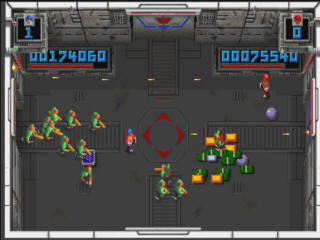 It’s official; Arnold Schwarzenegger is now the governor of California, or as the newly elected Arnie pronounces it, “Khaleefawnya.” Despite his assuring smile and thankful speeches, Arnie’s resume includes some of the most violent films to ever emerge from Hollywood. In one film, Arnie tosses a machete through some unfortunate soldier, pinning him to a wooden post. The buffed up action hero then advises the impaled victim to, “stick around.” Oh that’s just wicked, Arnie. Another film titled The Running Man, puts Schwarzenegger’s character, Ben Richards, against the forces of the vile, sadistic game show host, Damon Killian, and his band of trained killers that hunt down convicts for… TV ratings! After some sleazy video manipulation, Richards ends up on the show and it’s up to him to escape Killian’s killers in a wasteland filled with death, deception, and… TV cameras! This is purely a fictional movie, but as a video game, this kind of storyline has remarkable promise. I mean, c’mon. It’s set in the future, and the game show features live, uncensored killings, decapitations, and explosions. Thank you, Arnold. Whether or not you have the brainpower to run the most populated, debt-ridden state in the nation is something to be seen. But you do know how to inspire a damn good arcade game.
It’s official; Arnold Schwarzenegger is now the governor of California, or as the newly elected Arnie pronounces it, “Khaleefawnya.” Despite his assuring smile and thankful speeches, Arnie’s resume includes some of the most violent films to ever emerge from Hollywood. In one film, Arnie tosses a machete through some unfortunate soldier, pinning him to a wooden post. The buffed up action hero then advises the impaled victim to, “stick around.” Oh that’s just wicked, Arnie. Another film titled The Running Man, puts Schwarzenegger’s character, Ben Richards, against the forces of the vile, sadistic game show host, Damon Killian, and his band of trained killers that hunt down convicts for… TV ratings! After some sleazy video manipulation, Richards ends up on the show and it’s up to him to escape Killian’s killers in a wasteland filled with death, deception, and… TV cameras! This is purely a fictional movie, but as a video game, this kind of storyline has remarkable promise. I mean, c’mon. It’s set in the future, and the game show features live, uncensored killings, decapitations, and explosions. Thank you, Arnold. Whether or not you have the brainpower to run the most populated, debt-ridden state in the nation is something to be seen. But you do know how to inspire a damn good arcade game.
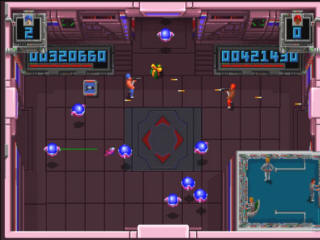 Smash TV comes to us from the skilled folks of Williams Electronic Games Inc. Some of the most popular names in game programming work for Williams. Mark Turmell and John Tobias are the key programmers for Smash TV. With fellow Williams (then Midway) employee and lead artist, Sal DiVita, they’ve worked on other hit projects such as the NBA Jam (which gained a profit of over a billion dollars on the coin-op alone) series, and the cult favorite fighting series, Mortal Kombat. With minds like these, Smash TV couldn’t help but to be a brilliantly orchestrated fracas with only the most insane gameplay to ever be purchased by quarters.
Smash TV comes to us from the skilled folks of Williams Electronic Games Inc. Some of the most popular names in game programming work for Williams. Mark Turmell and John Tobias are the key programmers for Smash TV. With fellow Williams (then Midway) employee and lead artist, Sal DiVita, they’ve worked on other hit projects such as the NBA Jam (which gained a profit of over a billion dollars on the coin-op alone) series, and the cult favorite fighting series, Mortal Kombat. With minds like these, Smash TV couldn’t help but to be a brilliantly orchestrated fracas with only the most insane gameplay to ever be purchased by quarters.
Smash TV takes place in 1999. We’ll just disregard the fact that 1999 has long since passed and the only brutal game show America has to offer is when a Price is Right contestant twists his ankle as he runs down to the edge of the stage in idiotic glee. During this time, television has finally done away with the overly politically correct censors that go into violent convulsions at the mention of the word ‘hell’. A new game show called Smash TV has smashed its way onto the scene and captivated viewers everywhere in the world. With his domination of global ratings, the self-absorbed host of Smash TV, MC Mayhem, puts two contestants (player 1 & player 2) in intensely hostile arenas. His legions of attackers have only one purpose, to kill the contestants. The contestants aren’t without protection. In addition to the standard, rapid-fire guns they are issued, there are other, more powerful weapons available for them to use. As they blast away throngs of enemies, the contestants must also take the time to pick up a few bonus prizes as well. What’s a game show without consolation prizes? Any contestants that get electrocuted by floating orbs would be glad to know that a brand new riding lawn mower is waiting for them at home as soon as they are released from the hospital’s skin graft ward. All this carnage takes place in front of a live audience as well as being broadcast all over the planet. MC Mayhem awaits. Are you the next lucky contestant?
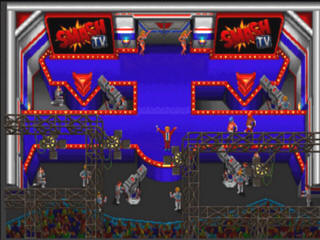 Reminiscent of Saturday morning cartoons during the late 80’s and early 90’s, the marquee art sums up the game perfectly. Even more amusing are the game’s graphics. The title screen by itself is enough to make a potential player plunk in a few quarters. Smash TV offered some of the best visuals of its time. The screen was always full of colors and animations. The close-ups of the humans are highly detailed down to the flesh. MC Mayhem’s smug grin is almost as bright as his sparkling, red sequined jacket. Mayhem is usually seen with his two co-hosts; a pair of blonde, voluptuous ladies that each just happen to be blessed with the most ample mammary glands in gaming history. The two muscular contestants are similar in appearance but Williams is competent enough to make sure there are subtle differences between them. The player 2 contestant (the black guy) has a slightly broader nose and thicker lips than the white player 1 contestant. Doesn’t it speak volumes of a gaming company when they take the time to incorporate the minute (that’s pronounced ‘my-nute’ which means small) geographical differences between the characters in their game?
Reminiscent of Saturday morning cartoons during the late 80’s and early 90’s, the marquee art sums up the game perfectly. Even more amusing are the game’s graphics. The title screen by itself is enough to make a potential player plunk in a few quarters. Smash TV offered some of the best visuals of its time. The screen was always full of colors and animations. The close-ups of the humans are highly detailed down to the flesh. MC Mayhem’s smug grin is almost as bright as his sparkling, red sequined jacket. Mayhem is usually seen with his two co-hosts; a pair of blonde, voluptuous ladies that each just happen to be blessed with the most ample mammary glands in gaming history. The two muscular contestants are similar in appearance but Williams is competent enough to make sure there are subtle differences between them. The player 2 contestant (the black guy) has a slightly broader nose and thicker lips than the white player 1 contestant. Doesn’t it speak volumes of a gaming company when they take the time to incorporate the minute (that’s pronounced ‘my-nute’ which means small) geographical differences between the characters in their game?
During the actual gameplay, the contestants are represented by smaller figures in proportion to the size and scale of the open battle arenas. The arenas are the playing fields in which the game takes place. Most of the arenas are of your typical futuristic variety with metallic, tiled floors and sliding double doors. But for a large portion of the game, the arenas take on an ancient Aztec appearance with stone block walls, segmented pillars, giant faces carved into the stone, and a few palm trees to complete the jungle scheme. The prize arenas feature flashing lights. Solidifying the whole game show theme, are the cameramen and other technical production personnel that can be seen when the contestants move from one arena to the next. But the arenas and the people that make the show possible aren’t too much of a concern for the contestants. The biggest concern comes from the multitude of threats that enter the arena once the contestants go inside.
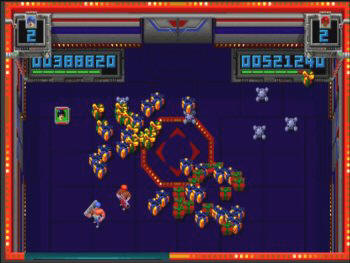 Smash TV is chocked full of various enemies. There are bat-wielding maniacs, electrical floating orbs, suicide bombers, hovering cyborgs, reptilian mutants with pitchforks, floor mines, poisonous snakes, gun positions jutting out from the walls, any many other hazards that attack in large numbers. Each of these enemies is unique in appearance, thus adding more variety to game. Although there’s only four bosses in the game, they all are large, highly detailed killing machines. Mutoid Man, Scarface, Die Cobros, and MC Mayhem himself are huge, menacing concoctions that take up a quarter of the screen (even more for Cobros). Lastly, the deaths of both the contestants and the enemies remain to be among the goriest since the 90’s. The same people, who would so graciously bring you Mortal Kombat’s Kung Lao razor hat fatality years later, are the same people behind Smash TV. The second those mindless goons with clubs are shot, they are reduced to a loose mass of flesh, raining large quantities of blood onto the arena floor. The contestants have pretty grim fates of their own. In addition to being electrocuted to the bone (literally), should they wander over a floor mine, their bodies become a bloody fountain of limbs, eyeballs, and flesh. Even the bosses suffer some of the most gory, sophisticated demises. The aptly named boss, Scarface, becomes full of bleeding, open sores from the punishment he takes. Other bosses such as Mutoid Man will continue to function even as his arms are relegated to bloody stubs, and his chest cavity has been destroyed to the point that his shattered ribcage is exposed. So, in short, the graphics are wickedly delightful.
Smash TV is chocked full of various enemies. There are bat-wielding maniacs, electrical floating orbs, suicide bombers, hovering cyborgs, reptilian mutants with pitchforks, floor mines, poisonous snakes, gun positions jutting out from the walls, any many other hazards that attack in large numbers. Each of these enemies is unique in appearance, thus adding more variety to game. Although there’s only four bosses in the game, they all are large, highly detailed killing machines. Mutoid Man, Scarface, Die Cobros, and MC Mayhem himself are huge, menacing concoctions that take up a quarter of the screen (even more for Cobros). Lastly, the deaths of both the contestants and the enemies remain to be among the goriest since the 90’s. The same people, who would so graciously bring you Mortal Kombat’s Kung Lao razor hat fatality years later, are the same people behind Smash TV. The second those mindless goons with clubs are shot, they are reduced to a loose mass of flesh, raining large quantities of blood onto the arena floor. The contestants have pretty grim fates of their own. In addition to being electrocuted to the bone (literally), should they wander over a floor mine, their bodies become a bloody fountain of limbs, eyeballs, and flesh. Even the bosses suffer some of the most gory, sophisticated demises. The aptly named boss, Scarface, becomes full of bleeding, open sores from the punishment he takes. Other bosses such as Mutoid Man will continue to function even as his arms are relegated to bloody stubs, and his chest cavity has been destroyed to the point that his shattered ribcage is exposed. So, in short, the graphics are wickedly delightful.
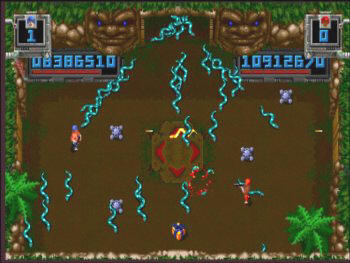 Just dropping a coin into the game’s slot treats you with one of the many sound samples. “Bingo!” The audible capacity of Smash TV is so diverse and accurate that when one sound is playing, the others ring in loud and clear as the game progresses. Since this is taking place in front of a live audience, the crowd is a crucial and well-incorporated part of the game. As the contestants run around onscreen, mowing down mutants and such, the crowd (off-screen) watches in suspense. They cheer when the contestants clear the last element of vermin from the arena. But should the contestants become the victims of some horrible death, the crowd will let out a collective groan of disappointment. It’s these sound effects that set up the atmosphere for the whole game. The action consists of many different sounds, such as booming explosions, weapons firing, shocking electricity, and my personal favorite, the painful grunts and gasps of enemies that can take a few hits before dying. Smash TV was one of few arcade games to utilize speech technology. Just as the contestants begin in the first arena, MC Mayhem appears on a retractable screen and tells them, “Good luck! You’ll need it!” Picking up a prize or a useful weapon prompts the contestants to shout, “Yeah!!” or, “Whooo!!” After picking up twenty wads of cash and a luxury vacation to tropical St. Thomas, those would be my sentiments exactly. Many of the bosses have a few vocal samples of their own. Mutoid Man signals his arrival with a loud roar as he enters the arena through a giant whole in the wall. In a moment of pure sadism, he’ll laugh evilly as he crushes the contestants’ skeletal system underneath his massive tank treads. The musical score probably won’t be noticed as much as the other sound effects, but it’s there and it’s perfectly fitting. Each arena theme has a certain score to go along with it. During the first few arenas, the score is a fast paced, action-inducing tune. As for the jungle themed arenas, a slower, more complex tempo is used. The prize room arenas, as expected, the music resembles an exciting game show jingle. Even though the musical scores won’t be paid too much attention above the numerous sound effects, it serves its purpose perfectly as the game’s atmospheric reinforcement during all phases of gameplay.
Just dropping a coin into the game’s slot treats you with one of the many sound samples. “Bingo!” The audible capacity of Smash TV is so diverse and accurate that when one sound is playing, the others ring in loud and clear as the game progresses. Since this is taking place in front of a live audience, the crowd is a crucial and well-incorporated part of the game. As the contestants run around onscreen, mowing down mutants and such, the crowd (off-screen) watches in suspense. They cheer when the contestants clear the last element of vermin from the arena. But should the contestants become the victims of some horrible death, the crowd will let out a collective groan of disappointment. It’s these sound effects that set up the atmosphere for the whole game. The action consists of many different sounds, such as booming explosions, weapons firing, shocking electricity, and my personal favorite, the painful grunts and gasps of enemies that can take a few hits before dying. Smash TV was one of few arcade games to utilize speech technology. Just as the contestants begin in the first arena, MC Mayhem appears on a retractable screen and tells them, “Good luck! You’ll need it!” Picking up a prize or a useful weapon prompts the contestants to shout, “Yeah!!” or, “Whooo!!” After picking up twenty wads of cash and a luxury vacation to tropical St. Thomas, those would be my sentiments exactly. Many of the bosses have a few vocal samples of their own. Mutoid Man signals his arrival with a loud roar as he enters the arena through a giant whole in the wall. In a moment of pure sadism, he’ll laugh evilly as he crushes the contestants’ skeletal system underneath his massive tank treads. The musical score probably won’t be noticed as much as the other sound effects, but it’s there and it’s perfectly fitting. Each arena theme has a certain score to go along with it. During the first few arenas, the score is a fast paced, action-inducing tune. As for the jungle themed arenas, a slower, more complex tempo is used. The prize room arenas, as expected, the music resembles an exciting game show jingle. Even though the musical scores won’t be paid too much attention above the numerous sound effects, it serves its purpose perfectly as the game’s atmospheric reinforcement during all phases of gameplay.
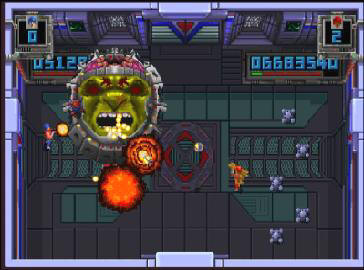 Speaking of which, the gameplay needs to be discussed. Rather than buttons, Smash TV players are given two directional joysticks to work with. The left joystick controls the contestants’ movement, as the other joystick directs weapon fire. With this setup, the contestants can move in one direction while firing in another. It takes coordination but is fairly simple to do after a few minutes. The main focus of the game is for the contestants to battle through wave after wave of attackers, and meet the boss. The arenas are arranged in grid configuration as seen on a map that’s briefly displayed after clearing the very first arena, and the arenas immediately after a boss fight. The path that the contestants can take through the grid of arenas is up to the players. A cleared arena can have up to three different exits. Smash TV starts with a scene from the main stage of the game show studio. MC Mayhem stands before the audience and television cameras in all of his conceited glory as the crowd cheers for the rampant destruction that lay ahead.
Speaking of which, the gameplay needs to be discussed. Rather than buttons, Smash TV players are given two directional joysticks to work with. The left joystick controls the contestants’ movement, as the other joystick directs weapon fire. With this setup, the contestants can move in one direction while firing in another. It takes coordination but is fairly simple to do after a few minutes. The main focus of the game is for the contestants to battle through wave after wave of attackers, and meet the boss. The arenas are arranged in grid configuration as seen on a map that’s briefly displayed after clearing the very first arena, and the arenas immediately after a boss fight. The path that the contestants can take through the grid of arenas is up to the players. A cleared arena can have up to three different exits. Smash TV starts with a scene from the main stage of the game show studio. MC Mayhem stands before the audience and television cameras in all of his conceited glory as the crowd cheers for the rampant destruction that lay ahead.
As the blonde, super bosom twins chant, “Go! Go! Go! Go!” the contestants venture through the stage doors into the maze of deadly arenas. In most cases, the enemies will come into arena the after the contestants. This is where the action begins. The arenas all have four sets of doors from which the enemies will flow from in staggering numbers. No place in the arena is safe since the sheer volume of attackers can blanket the screen. The attackers are very diverse and as many as four types can be in the arena at once. Not only do the contestants have to worry about getting their craniums cracked by club-toting goons, but they also need to make sure the speedy, bladed disks that slide on the floor in erratic patterns don’t impale them. Mr. Shrapnel seems perfectly content strapping an explosive charge to his back and detonating himself in the contestants’ vicinity. Some of the goons ride small, rapid firing tanks into the battle even though the tanks inadvertently kill other goons on the screen by running them over. Many of the enemies are ridiculously agile, making them difficult to destroy. The dreaded Turtle Chunks can and will outmaneuver the contestants to easily administer to them a 15,000 volt shock. Big groups of hovering, robotic buffalos will also make things tough for the contestants. Lastly, the dodging and killing of all these threats must be done without the contestants stepping on the contact mines that are spread all over the arena floor.
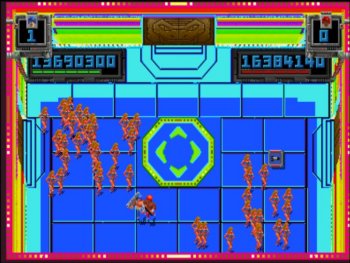 In the face of such overwhelming odds, the contestants have many advantages they can use. Randomly appearing on the arena floor are icons that represent weapons and other useful firepower. Three-way firing cannons, shoulder launched missiles, multiple grenade deployment cannons, and high arcing bomb guns (for those annoying boss fights) are very powerful in the hands of the contestants. These weapons have limited use, so the shots must be used effectively before the guns run out of ammo. Other nifty icons include extra lives, temporary force fields that destroy enemies on contact, screen clearing smart bombs, speed boosters, barriers of spinning razors, and rotating orbs that fire whatever shots the contestants pick up. Again, this is a game show. Although the contestants must cooperate to survive, they are competing against each other for prize money. Randomly appearing on the arena floor are gift-wrapped packages that represent various prizes such as new cars, luxury vacations, the Smash TV home game, and a year’s supply of Angus beef. A home game of Smash TV should make for some interesting family reunions. A 52 year-old woman slicing her 12 year-old grandson’s arm off with a saw blade sounds like quality family entertainment. Other prizes appearing on the floor are wads of cash, and bars of silver and gold. The final icons are the key icons. These are much rarer than the other icons, but they can grant the contestants access to Smash TV’s most secret arena, the Pleasure Dome. Unlike the other prize rooms, this elusive arena is not marked on the maps by a $ sign. In fact it’s not on the map at all. Finding the Pleasure Dome takes ten of the key icons plus finding the entry to it from any number of secret locations. The rewards in this neon colored, flashing arena are not cash, gifts, or precious metals, but they are hundreds of blonde game show hostesses like ones that are seen with MC Mayhem. Any game show where the prizes are this good may very well be worth the risk of having someone’s internal organs pasted against the arena walls with their own blood.
In the face of such overwhelming odds, the contestants have many advantages they can use. Randomly appearing on the arena floor are icons that represent weapons and other useful firepower. Three-way firing cannons, shoulder launched missiles, multiple grenade deployment cannons, and high arcing bomb guns (for those annoying boss fights) are very powerful in the hands of the contestants. These weapons have limited use, so the shots must be used effectively before the guns run out of ammo. Other nifty icons include extra lives, temporary force fields that destroy enemies on contact, screen clearing smart bombs, speed boosters, barriers of spinning razors, and rotating orbs that fire whatever shots the contestants pick up. Again, this is a game show. Although the contestants must cooperate to survive, they are competing against each other for prize money. Randomly appearing on the arena floor are gift-wrapped packages that represent various prizes such as new cars, luxury vacations, the Smash TV home game, and a year’s supply of Angus beef. A home game of Smash TV should make for some interesting family reunions. A 52 year-old woman slicing her 12 year-old grandson’s arm off with a saw blade sounds like quality family entertainment. Other prizes appearing on the floor are wads of cash, and bars of silver and gold. The final icons are the key icons. These are much rarer than the other icons, but they can grant the contestants access to Smash TV’s most secret arena, the Pleasure Dome. Unlike the other prize rooms, this elusive arena is not marked on the maps by a $ sign. In fact it’s not on the map at all. Finding the Pleasure Dome takes ten of the key icons plus finding the entry to it from any number of secret locations. The rewards in this neon colored, flashing arena are not cash, gifts, or precious metals, but they are hundreds of blonde game show hostesses like ones that are seen with MC Mayhem. Any game show where the prizes are this good may very well be worth the risk of having someone’s internal organs pasted against the arena walls with their own blood.
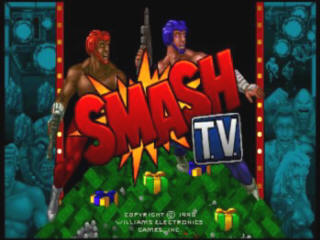 The boss fights are very challenging since the amount of damage it takes to defeat them is very high. Also many incarnations of Mr. Shrapnel will enter the boss arenas, making the challenge even more demanding. After each boss fight, the number of prizes, cash, gold, silver, and blondes with big tits (if you’re lucky) collected by each contestant will be counted. The prize amounts are tallied, and the contestant with the highest overall cash value wins.
The boss fights are very challenging since the amount of damage it takes to defeat them is very high. Also many incarnations of Mr. Shrapnel will enter the boss arenas, making the challenge even more demanding. After each boss fight, the number of prizes, cash, gold, silver, and blondes with big tits (if you’re lucky) collected by each contestant will be counted. The prize amounts are tallied, and the contestant with the highest overall cash value wins.
Smash TV can best be described as gore, glitz, humor, and nonstop action placed into a high-speed blender with the lid off. The game is structured together so well in all aspects that the overall experience is simply exceptional. The idea that maximum carnage on a grand scale can coexist with theme such as game show is an original concept, and Smash TV does it superbly.
